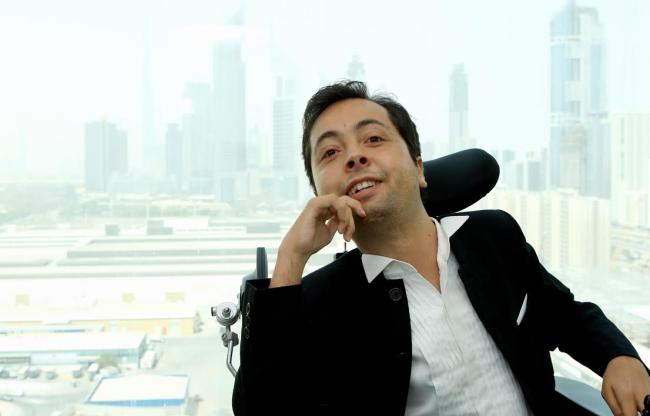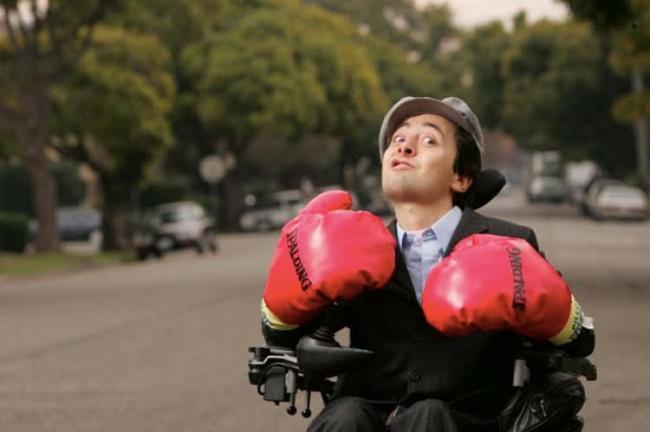Victor Pineda is a Senior Research Fellow and visiting scholar at the Haas Institute who is working to expand on the scholarship and research of the Haas Institute Disability Studies Cluster. We recently spoke with him about living with a disability, his appointment by Pres. Obama on the US Access Board, and how we can create more inclusive societies for individuals with different needs.
My research and teaching promote equitable outcomes for persons with disabilities, both at home and abroad. My lived experience as a person with significant disabilities drew me to this research and often equips me with a perspective that tends to uncover gaps in existing research and allows me to offer fresh approaches to building more inclusive and equitable cities.
Inequality is very apparent when you see it, and in many ways it has shaped my life from a young age. At the age of 5 years old, I was denied a chance to go to school because I had difficulty walking without assistance, I was skinny, clumsy and my muscles were much weaker than those of other kids my age. In Caracas, Venezuela where I was born, principals and teachers were sympathetic but not prepared to have me join their classrooms. Their assumption was that I would be a burden on them, and that I would never be educated or employed.
They encouraged my mother to homeschool me and to keep me away from other children to avoid being bullied. This sympathetic form of exclusion was a blatant violation of my right to an education—a violation of my human rights. Later when we moved to the United States, I benefited from civil rights laws such as the Individuals with Disabilities in Education Act (IDEA) and the Americans with Disabilities Act of 1990, that gave me an opportunity to develop my potential alongside my peers.
In the late 90s, here at the University of California, Berkeley, I was introduced to the rich and dynamic history of the disability rights and independent living movement. As an undergraduate rolling freely down Telegraph Avenue, I realized I was the beneficiary of a long line of scholars and advocates who fought for disability justice.
Sophisticated and powerful advocates such as Ed Roberts, Judith Heumann, and many others inspired me, and I realized that I had a responsibility to do my part. So I followed their lead and helped resurrect the Disabled Students Union, which was one of the first student run organizations to really develop a whole range of initiatives in this field. I took courses in the budding disability studies minor, and at the early stages of my studies I was exposed to the rich and growing literature of disability studies as well as the vibrant disability culture flourishing in the bay area.
You were the youngest government delegate to participate in the drafting of the United Nations Convention on the Rights of Persons with Disabilities, which was adopted in 2006. Could you speak a bit about your experience with that? How did that inspire or influence your research and teaching today?
My engagement with the UN Convention on the Rights of Persons with Disabilities (CRPD) fundamentally altered the way I thought about human rights, justice, and inclusion. I saw that the struggle for recognition, more specifically for inclusion taking place in similar ways, simultaneously all over the world.
During this time, I was in graduate school and saw a need for more holistic approaches to inclusion. With a group of friends, I founded a nonprofit and soon began developing research projects with disability rights groups in Thailand, Serbia, Yemen, Jordan, and Cambodia and even my country of birth, Venezuela. We partnered with community advocates, government officials, human rights experts, and donors. The work we did was completely path breaking; it brought the CRPD to life and allowed the communities we worked with to develop new ways of thinking about inclusion. Our research also helped make an impact and ushered in new policies, new programs, and new services for people with disabilities. The research and the programs we executed helped amplify the voice in their own development and social participation. Without my early engagement in the process of drafting the CRPD, I would not have been able to develop the unique perspective, and relationships necessary to carry out this important research. Our research and development programs both at home and abroad have been very successful and continue to make an impact to this day.
You were recently appointed by Pres. Obama to the US Access Board. What will you be doing on the Board and what do you hope to accomplish?
I am very honored to serve the Obama Administration in this capacity. The US Access Board develops guidelines and regulations for several key federal statutes that support people with disabilities. As an urban planner, I bring perspective and understanding of disability on an urban scale, and help ensure that issues concerning our community are fully incorporated into the key policy debates. I am most interested in exploring “smart cities” and exploring the intersection between urban planning, access and the revolution of digital urban infrastructure in the age of open data.
Can you talk about the connections between our built environment and issues of accessibility and disability justice? Describe the work you're doing in "inclusive cities." What cities are at the forefront?
We’re currently engaging in a multi-city research project by developing a matrix to measure inclusion across 52 global cities in the world. We are working with 15-20 indicators that include everything from the transportation infrastructure to the price of housing as well as estimates of density (the number of people with disabilities per square mile). We also use this information to advocate for a stronger enforcement mechanism for standards in the built environment. Ultimately, inclusion is not only physical access but also social solidarity. For this, we try to determine the capacity of local organizations to engage with people from all kinds of different backgrounds.
We’ve created a framework that will be published in a book later this year, outlining the ways that cities can create an audit for inclusion. Berkeley stands out as very unique case, because of it’s very important pioneering role in the disability rights movement. There are other cities that have done really great work, like Chicago. On a global level, I would say Stockholm, Copenhagen and Oslo demonstrate how policies can implement the concept of universal design when it becomes the way to build cities. But there’s also interesting examples from Tokyo and even Belgrade, Serbia.
We’re seeing a multitude of national initiatives and real efforts towards inclusion, especially in cities. We are still only at the beginning, so much has to be done, from changing the mentalities and expectations about our potential and achievements to the changes in infrastructure and policies. However, we can already see the positive effects in the quality of the lived experience of people with disabilities in inclusive cities where, we, people with disabilities can feel welcomed as equal participating citizens.
What projects will you be working on as a visiting scholar at the Haas Institute?
My research at the Haas Institute explores social equity and strengthens evidence-based policy in dynamic city regions. It elevates notions of access, diversity, and equity within the context of globalization and urbanization. By studying the urban experience of disability, my research contributes to broader debates about social and spatial justice. Three insights inform my various research projects while at the Haas Institute:
- Disability research, much like other urban or social issues, must be situated in a particular time and place
- Disability is simultaneously a local and global planning issue
- Planning education and research can benefit from empirical, methodological, and theoretical advances made in disability studies
In the coming months, I will expand my research to include the histories of disability in city planning and expand my research of capability deprivations to metropolitan planning, comparative social development, and health equity. By exploring these issues, my research bridges theory and practice with the aim of addressing pressing social problems.
My upcoming book, The Inclusive City: Governance, Access, and the Transformation of Disability Rights, assesses equity, justice and access in the rapidly urbanizing city-state of Dubai. The book is an extended case study and seeks to influence legal, institutional, physical and social reforms, not only in Dubai but also globally. The research is relevant because it provides an equity-based framework from which to improve participation outcomes of marginalized groups in public life.
In addition to my research I am also passionate about teaching and engaging students in transformative learning. In the classroom, I like to use an interdisciplinary approach to social theory, comparative policy evaluation, and planning for diverse communities. I love asking questions and allowing the questions to reveal to my students the links between theory, policy and practice. My experience in the field allows me to illustrate these links through real world examples.
What do you see as the possibility for the Haas Institute as a hub of diversity research, policy, and strategic communications? Where can we take our work to push more for disability justice?
I believe that whether you’re a student, a researcher, a community advocate, or a policymaker, you will need to cultivate collaborative relationships and critical analysis skills that are built on a fundamental and comprehensive understanding of equity and inclusion. The Haas Institute does this by engaging diverse stakeholder in both critical thinking and empathic understanding.
There is a lot of potential for the Haas Institute to make a major impact in every sector of its work by incorporating a disability inclusive framework. For example, when teaching, I like to assign prompts― students have five minutes to relate concepts covered in the course through words, images, gestures or feelings, the latter being atypical but effective pedagogy that allows diverse learners to express their knowledge through multiple means. This is not just good for students with disabilities; it’s good for all learners.
Like other researchers and faculty affiliated with the Haas Institute, access and diversity drive my process and method for both instruction and research. I would love to help build disability awareness within the Haas Institute and support these efforts across campus.
I believe that as a leading research center on equity and inclusion, the Haas Institute has an opportunity to lead in disability inclusion. Inclusion happens when accessibility features are built into our website, or when we ensure that our videos are captioned, and when we offer publication to the public in multiple formats (accessible PDF, text, braille). Inclusion happens when we book an accessible room, ask if our participants may benefit from ALS, or set up a virtual classroom with accessibility features such as real time captioning. Inclusion happens when we use the principles of Universal Design and Universal Design for Learning (UDL) to promote equity and inclusion. Inclusion happens when we offer our community multiple means to represent, express and engage with our work. I am excited by the mission and vision of the Haas Institute and its leadership team to become a living, breathing example of what inclusion looks like and I am honored to contribute my part.




